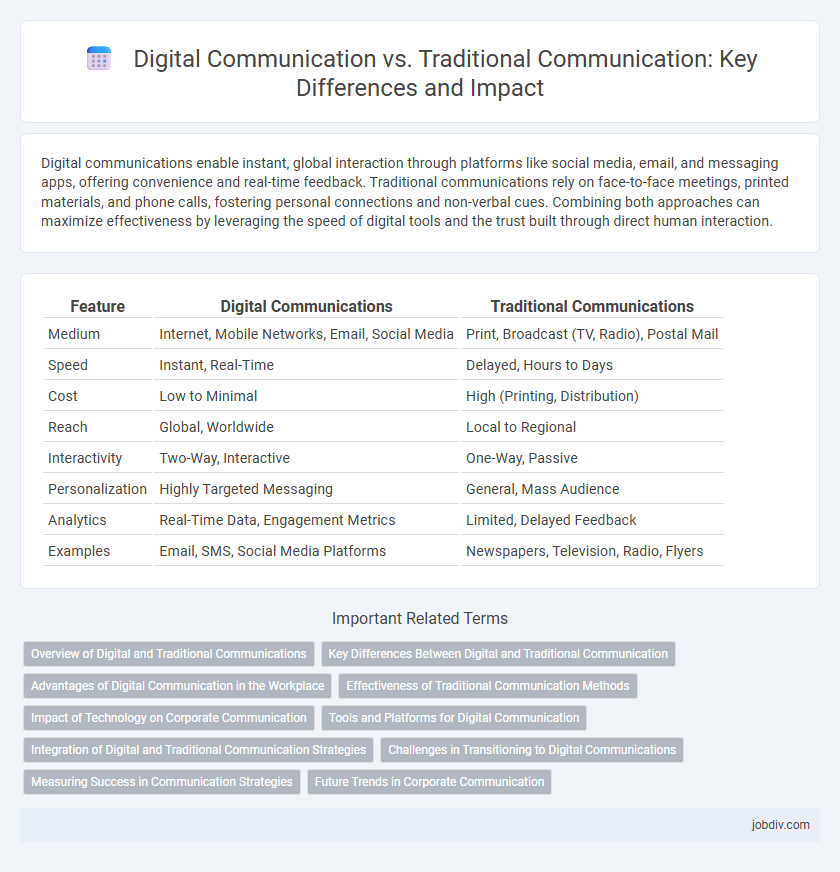Digital communications enable instant, global interaction through platforms like social media, email, and messaging apps, offering convenience and real-time feedback. Traditional communications rely on face-to-face meetings, printed materials, and phone calls, fostering personal connections and non-verbal cues. Combining both approaches can maximize effectiveness by leveraging the speed of digital tools and the trust built through direct human interaction.
Table of Comparison
| Feature | Digital Communications | Traditional Communications |
|---|---|---|
| Medium | Internet, Mobile Networks, Email, Social Media | Print, Broadcast (TV, Radio), Postal Mail |
| Speed | Instant, Real-Time | Delayed, Hours to Days |
| Cost | Low to Minimal | High (Printing, Distribution) |
| Reach | Global, Worldwide | Local to Regional |
| Interactivity | Two-Way, Interactive | One-Way, Passive |
| Personalization | Highly Targeted Messaging | General, Mass Audience |
| Analytics | Real-Time Data, Engagement Metrics | Limited, Delayed Feedback |
| Examples | Email, SMS, Social Media Platforms | Newspapers, Television, Radio, Flyers |
Overview of Digital and Traditional Communications
Digital communications utilize electronic signals to transmit information rapidly over the internet, mobile networks, and satellite systems, enabling instant connectivity and multimedia sharing. Traditional communications rely on physical media such as postal mail, landline phones, and face-to-face interactions, often resulting in slower information exchange but maintaining personal touch and reliability. The integration of both methods enhances overall communication strategies, balancing speed, accessibility, and interpersonal connection.
Key Differences Between Digital and Traditional Communication
Digital communication utilizes electronic devices and internet platforms to facilitate instant, multimedia-rich interactions, enabling real-time messaging, video calls, and social media engagement. Traditional communication relies on face-to-face conversations, printed materials, and broadcast media, often resulting in slower information dissemination and limited interactivity. The key differences lie in speed, accessibility, interactivity, and the ability to reach a global audience instantly through digital channels.
Advantages of Digital Communication in the Workplace
Digital communication in the workplace enhances collaboration through instant messaging, video conferencing, and real-time document sharing, significantly improving efficiency and decision-making speed. It allows for seamless remote work and global connectivity, reducing geographical barriers and operational costs. Additionally, digital platforms enable advanced data tracking and analytics, supporting better communication management and performance evaluation.
Effectiveness of Traditional Communication Methods
Traditional communication methods such as face-to-face conversations, telephone calls, and printed materials remain highly effective in building trust and delivering nuanced messages due to their personal and direct nature. These channels often facilitate immediate feedback, richer emotional connections, and clearer understanding, which are critical in complex or sensitive communications. Despite the rise of digital platforms, industries like healthcare, legal, and education still rely heavily on traditional communication for accuracy and relationship-building.
Impact of Technology on Corporate Communication
Digital communications have revolutionized corporate communication through real-time messaging platforms, video conferencing, and social media integration, enabling faster decision-making and global collaboration. Traditional communications, such as memos and face-to-face meetings, often involve delays and limited reach, reducing operational efficiency in large organizations. The impact of technology supports increased transparency, engagement, and data-driven strategies, transforming how corporations connect internally and externally.
Tools and Platforms for Digital Communication
Digital communication utilizes tools and platforms such as email, instant messaging apps, video conferencing software, and social media networks to facilitate real-time interaction and seamless information sharing. These platforms enable collaboration beyond geographical boundaries through cloud-based services, file-sharing applications, and integrated project management tools. Unlike traditional communication methods, digital tools offer enhanced scalability, multimedia integration, and data analytics capabilities that streamline communication processes for businesses and individuals.
Integration of Digital and Traditional Communication Strategies
Integrating digital and traditional communication strategies enhances brand consistency by aligning messaging across multiple channels such as social media, television, and print. This hybrid approach leverages real-time analytics from digital platforms to optimize traditional campaigns, improving audience targeting and engagement. Combining email marketing, public relations, and direct mail with digital tools like SEO and content marketing maximizes reach and reinforces customer relationships.
Challenges in Transitioning to Digital Communications
Transitioning to digital communications presents challenges such as ensuring data security, managing the complexity of new technologies, and overcoming resistance from employees accustomed to traditional communication methods. Organizations must address issues like digital literacy gaps and integration with existing systems to maintain effective information flow. Additionally, maintaining clarity and personal connection can be difficult compared to face-to-face or voice-based traditional communication channels.
Measuring Success in Communication Strategies
Measuring success in digital communications relies heavily on analytics tools that track engagement metrics such as click-through rates, conversion rates, and social media interactions, providing real-time, quantifiable data. Traditional communications often depend on indirect measures like surveys, focus groups, and sales impact analyses, which can be less immediate and harder to quantify. Integrating both digital analytics and traditional feedback methods offers a comprehensive assessment of communication strategy effectiveness.
Future Trends in Corporate Communication
Digital communications are rapidly transforming corporate communication by leveraging AI-driven analytics, real-time collaboration tools, and immersive virtual environments to enhance stakeholder engagement. Future trends emphasize personalized messaging through data analytics, increased use of augmented reality for interactive presentations, and seamless integration of omnichannel platforms to ensure consistent brand narratives. Traditional communication methods will increasingly serve complementary roles, focusing on in-person relationship building and high-impact events within hybrid communication strategies.
Digital Communications vs Traditional Communications Infographic

 jobdiv.com
jobdiv.com